

Vol. 38 (Nº 24) Año 2017. Pág. 29
Diana MADIYAROVA 1; Lyazzat SEMBIYEVA 2; Ninel YEKIBAYEVA 3; Madina RYSPEKOVA 4; Kasiya KIRDASINOVA 5; Lima ZHUMAGALIEVА 6; Gulzhan BEKMAGAMBETOVA 7
Recibido: 06/03/2017 • Aprobado: 24/04/2017
ABSTRACT: The close attention of not only certain foreign scientists, but also of such large international organizations, as the World Bank, by the IMF, the European commission was paid to questions of provision of pensions in the 80th of the XX century. Thus the European commission considers that the countries of the European Union need to reform immediately pension systems to minimize negative consequences of aging and reduction of the population. The research of the current pension system conditions is topical within modern circumstances of social-economic development of the national economy. The Republic of Kazakhstan numbered to the countries "with a transition period", passed into the category of the countries with the status "the developing country". In these conditions not only the reached macroeconomic results are of great importance, but also their social orientation. In the article authors investigate the nature of influence of demographic factors on development of the country and predict key parameters of demographic load on pension system for the next 5 years. Certain conclusions have been made according to results of the research. |
RESUMEN: La atención de no sólo ciertos científicos extranjeros, sino también de organizaciones internacionales tan grandes, como el Banco Mundial, el FMI, la Comisión Europea se han centrado en las cuestiones de provisión de pensiones en el 80 del siglo XX. Así, la Comisión Europea considera que los países de la Unión Europea necesitan reformar inmediatamente los sistemas de pensiones para minimizar las consecuencias negativas del envejecimiento y la reducción de la población. La investigación de las condiciones actuales del sistema de pensiones es de actualidad en las circunstancias modernas de desarrollo socioeconómico de la economía nacional. La República de Kazajstán pertenecía a los países "con un período de transición", pasando a la categoría de países con el estatus de "país en desarrollo". En estas condiciones no sólo los resultados macroeconómicos alcanzados son de gran importancia, sino también su orientación social. En el artículo los autores investigan la naturaleza de la influencia de los factores demográficos en el desarrollo del país y predecir los parámetros clave de la carga demográfica en el sistema de pensiones para los próximos 5 años. Ciertas conclusiones se han hecho de acuerdo con los resultados de la investigación. |
Impetuous aging of the population nowadays more and more reincarnates into a universal problem of the present. One of its main consequences is the compelled increase of a retirement age in the majority of, first of all, the developed countries of the world. However, as practice shows, the developing world nowadays including the former Soviet Union countries pay a close attention to this problem in carried-out reforms.
Meanwhile, what background of a present situation for increase of a retirement age is, what demographic risks Kazakhstan faced and what reference points for prospect of its development are – all this demands methodological modes for solution.
Deteriorating indicators of a demographic state in the country and a financial component of pension assets set a task of the analysis of identification of possible risks taking into account demographic factors of functioning and development of system of provision of pensions.
The methodology of research provides need of consecutive carrying out the following operations:
• the analysis of a retirement age in world practice,
• detection of the major demographic factors influencing a pension condition of the country and measurement of their quantitative parameters,
• assessment of proximity of the calculated indicators to threshold value.
Only in this situation it is possible to develop measures for maintenance at admissible level of increase in life expectancy of the population and coefficient of demographic loading.
Demographic look at a problem of retirement age and issues of population movement are represented in works of foreign scientists-economists among which materials of Zakharov S., Ivanova E. (2002), Shapiro G.V. (1986), Sinyavskaya O.V. (2002), Soloviyev A.K. (2016), Kudrin A.L., Gurevich E.T. (2012), Luzina T.V., Ignatova I.V. (2016), King R. (2012), Plewa P. (2012), Stephen G. (2011), Batayev A.V. (2015), as well as Kazakhstani scientists: Serikbayeva S.G. (2005), Kasenova A.K. (1991), Shokamanov U. (2000), Kenzheguzin M. (2005), Rysmakhanova G.Zh. (1998), Amandykova S.K., Rakhymberlina A.K. (2013), Shudabay K.K. (2014), Kurmanova G.G. (2014), Madiyarova D.M., Zhumagaliyeva L.T. (2014), Perneyeva G.A. (2013), Demidova N.V. (2010), Alimukhambetov N. (2007), Nurmuganbetov E. (2009), Khitakhunov A.A. (2012) can be noted.
Sinyavskaya O.V. (2002) supposes that retirement age on macro-level is considered as a parameter of pension system and labour market and its optimization from the perspective of the government – expenses minimizing on pension protection in order of age, physical disability and on labour policy as well. In accordance with Pareto criterion - optimality assessment of institutional changes, the consequences of retirement age increase is change in population proportion which incomes will be cut as a result of the reform.
Batayev A.V. (2015) resting upon actuarial calculations made number forecast of the Russian pensioners, amount of labour and social pensions for further extension till 2030.
With regard to one or another country the solutions seems ambiguous: countries leading according to this rate have objective reasons for retirement age increase whereas for outsiders it is reasonable not to decrease retirement age for its increase inevitably causes larger unemployment among population.
Because of the fact that pension system issues are imperfectly researched the authors offer their own algorithms of scientific research.
The authors use statistical method and method of grading in pension system conditions observation.
According to UN the population of a country is considered old in case if proportion of elder people is relatively higher than 7%. If advanced nations faced the problem of population aging first then by now a demographic aging process embraced the entire Globe. In 1950 8% of the World population was in the age older than 60 in 2000 – 10% and according to UN forecast it`ll be 21% in 2050.
In Kazakhstan such an indicator was 6,8%, in 2002 – 7%, in 2007 reached 7,8% in consecutive years the indicator decreased and reached 8% in 2015 (see Figure 1).
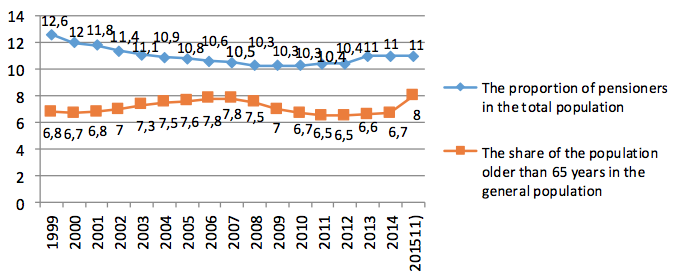
Figure 1. Index of population aging in RK,compiled on data of Statistics Agency of RK
Apparently, from the given drawing, the indicator is above threshold value. Nevertheless, according to the provided data it is possible to tell that Kazakhstan is the country with the old population and this indicator bears for itself negative characteristics of a demographic state in the country. Number of population of a retirement age in 1999 made 12,6%. Further the positive trend of decrease of this indicator to a mark of 11% in 2015 is noted.
This positive trend is caused, first of all, by annual increase in population at 1.2%, since 2002. Population increased by 17% from value of 14.85 million people in 2012 to 17,417 million people in 2015. The number of pensioners has a positively increasing trend, since 2007 there were 1.64 million pensioners, having increased by 7.1% or by 124.3 thousand people till 2012, having reached the number of 1.76 million people, and in 2015 it comprised 1,916 million people.
Information of Statistical Agency of the Republic of Kazakhstan about the long-term forecast of population of Kazakhstan is provided in Figure 2, including the number of men older than 63 years and women older than 58 years.
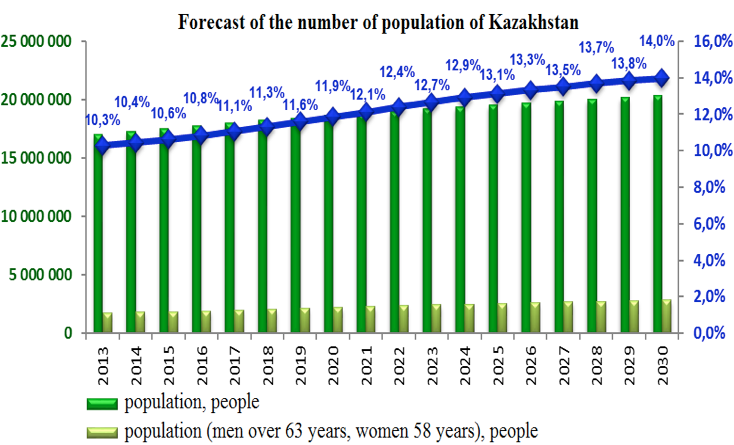
Figure 2. Population forecast of RK, compiled on data of Statistics Agency of RK
According to Statistical Agency of RK population will increase to 20.3 million people by 2030, and the number of men older than 63 years and women older than 58 years will reach 2.8 million people. The share of number of men older than 63 years and women older than 58 years in the total number of the population of RK will make 10,3% in 2013 and will rise to level of 14% in 2030.
Taking into account it authors made the medium-term forecast of aging of the population till 2018, presented according to optimistic, realistic and pessimistic scenarios (see Figures 3, 4, 5).
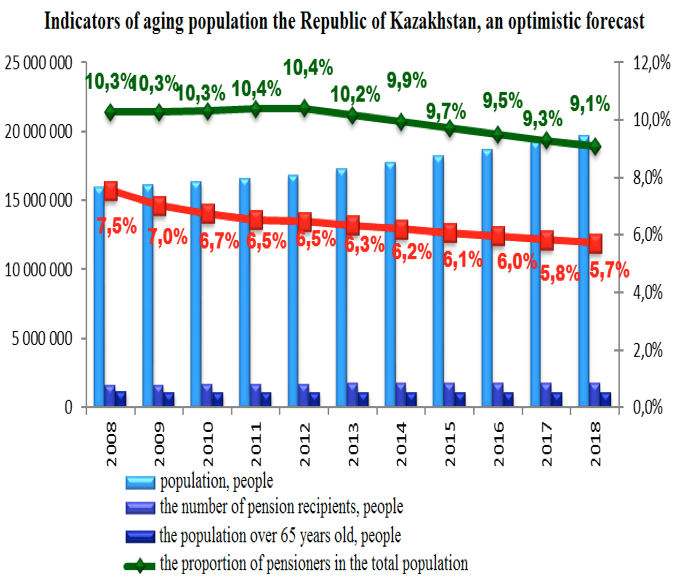
Figure 3. Indicators of the aging of the population of Kazakhstan (Optimistic forecast),
calculated by authors
By the received results of the optimistic forecast of the population the share of the population is more senior than 65 years in the total number of the population will make in 2018 – 5,7%.
By results of the realistic scenario the share of the population older than 65 years in the total number of the population will reach in 2018 – 6,3%.
According to pessimistic forecasts the share of the population older than 65 years in the total number of the population will rise to 8,1% in 2018.
The second demographic factor is reduction of number of economically active population. The increase in an indicator of number of economically active population bears for itself positive result. Thus, it is necessary to consider surely the unemployment rate, which increases in value – the undesirable fact. On Figure 6, dynamic information on economically active population, unemployment rate and inflation in the RK is provided.
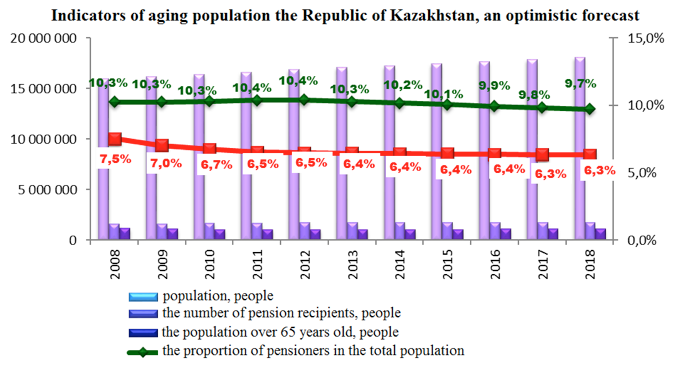
Figure 4. Rates of aging of population, the pessimistic forecast,
calculated by authors
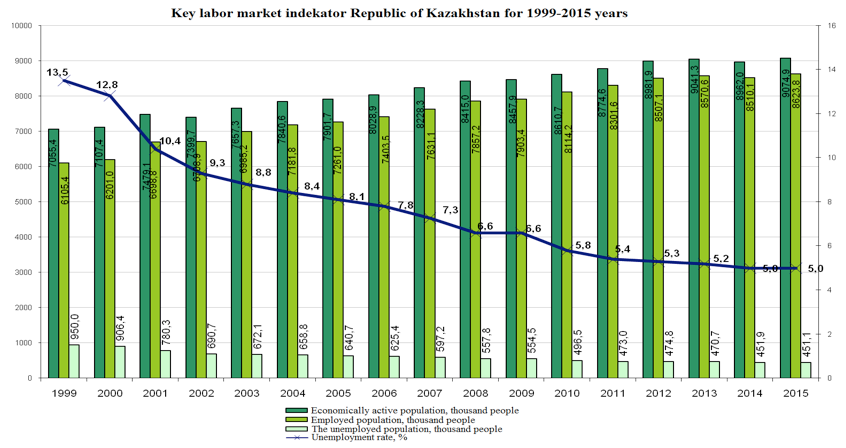
Figure 6. Dynamic of economically active population, unemployment level and inflation of RK,
compiled on data of Statistics Agency of RK
These data underline positively developed tendency, a steady growth of number of economically active population at moderate falling of the unemployment rate.
According to M. Friedman's theory the natural unemployment is specific to each economy according to a macroeconomic balance at which the expected rate of inflation is equal to its real level. Attempt to describe dependence of rates of inflation and unemployment is Phillips's Curve. However, existence of direct dependence in wide time frames between these sizes Friedman and Phillips is denied. According to their statement the rate of inflation depends, mainly, on monetary weight, and unemployment rate, in turn, aspires to the level of natural unemployment.
The correlation between a rate of inflation and monetary mass of the population in Kazakhstan made 0,26 that speaks about the inverse weak relationship of considered indicators. Correlation between unemployment rate and level of long-term unemployment makes 0,97. A number of works on forecasting the number of able-bodied population of the RK was carried out by the Statistic Agency of RK (see Figure 7). These data speak about the moderate growth of a considered indicator.

Figure 7. The forecast of the population of Kazakhstan,
based on data of the ROK Agency for statistics
During the research we made the forecast of economically active population from 2013 to 2018 on the basis of three scenarios: optimistic, realistic and pessimistic (see Figure 8).
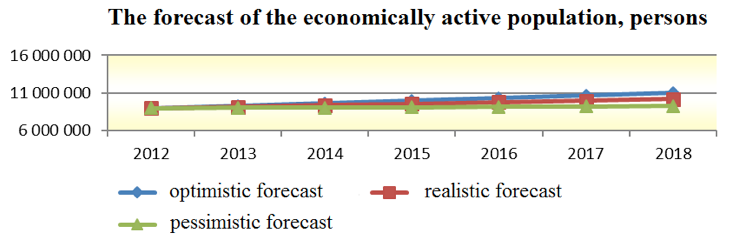
Figure 8. Forecast economically active population of Kazakhstan,
calculated by authors
By calculations of the optimistic forecast the number of economically active population will increase by 35,8%, i.e. to 12,2 million people in 2018, according to the realistic forecast this indicator, having risen by 13,5%, will reach 10,2 million people, according to the pessimistic forecast the increase in number by 3% will make 9,26 million people.
The third not less important factor is the increase in number of the disabled population, threat of an imbalance of indicators of economically active population with disabled part of the population will be a consequence of its excessive increase.
For the last 14 years in the RK the curve of number of the disabled population outlined a parabolic curve. At first this indicator from 1999 to 2004 fell to 7,8%, that made 612 thousand people, then slowly rose and by 2012 increased by 9,6%, having reached 693,7 thousand people, from 2012 till 2015 increased to 9,6% having reached 693,7 thousand people, and in 2015 raised till 946 thousand people or 12 per cent on the comparison with 1999 (see Figure 9).
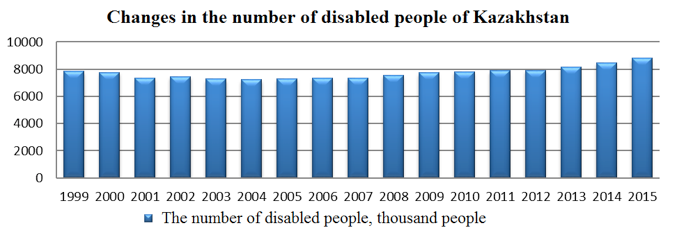
Figure 9. Dynamic of economically active population in RK,
compiled on data of Statistics Agency of RK
On Figure 9 the long-term forecast of number of the disabled population to 8,6 million people in 2030 was given by the Statistics Agency of RK. The forecast of this indicator, made by us till 2018, shows the following, see also Figure 10.
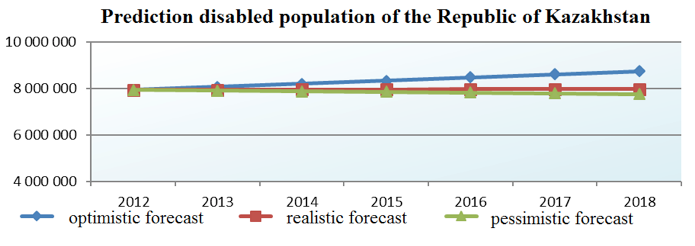
Figure 10. Forecast economically active population of Kazakhstan,
calculated by authors
According to the carried-out calculations of the optimistic expected scenario, the number of the disabled population of the RK by 2018 will increase by 10% or by 812 thousand people, rather statistical data of 2012 and will reach a point of 8,74 million people. By calculations of the realistic expected scenario, this indicator will suffer minor changes towards increase. So, the number of the disabled population in 2018 will reach value of 7,96 million people, having increased relative to 2012 by 0,4% or by 31 thousand people.
The pessimistic scenario shows that the number of the disabled population of the RK by 2018 will decrease by 2,2% or 171 thousand people and will make 7,76 million people.
The fourth and fifth important demographic factors influencing a condition of pension system are the reduction of coefficient of birth rate and increase in mortality rate.
For normal functioning of pension system and enhancement of population of the country excess of coefficient of birth rate over mortality rate is necessary.
We will note that in Kazakhstan birth rate exceeds quantity of mortality of people, in addition the trend of coefficient of birth rate has positively increasing tendency, while the mortality rate decreases from year to year (see Figure 11).

Figure 11. Dynamic of coefficient change of childbirth and death rate in RK,
compiled on data of Statistics Agency of RK
It should be noted that insignificant prevalence of females remains as a whole (51,8%) for the last 14 years to what the data given below figure 12 testify.
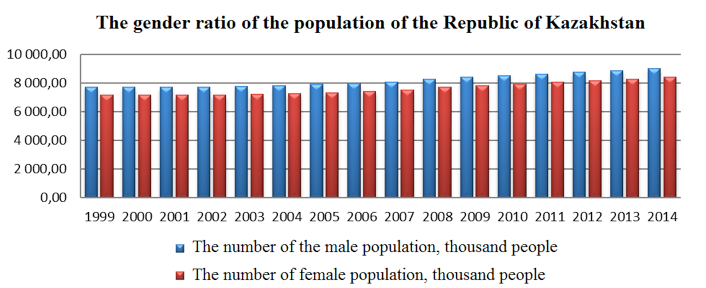
Figure 12. Gender correlation of population of RK,
compiled on data of Statistics Agency of RK
Men are born more in number (51,4% of total number of newborns) and this tendency proceeds to 15-year age. Further female number prevails. The greatest disproportion of people of the opposite sex is shown in the age group which is older than able-bodied when men make only 37,7% of the population of the republic.
Excess of number of women over the number of men is caused by much lower average life expectancy of males (see Figure 13).
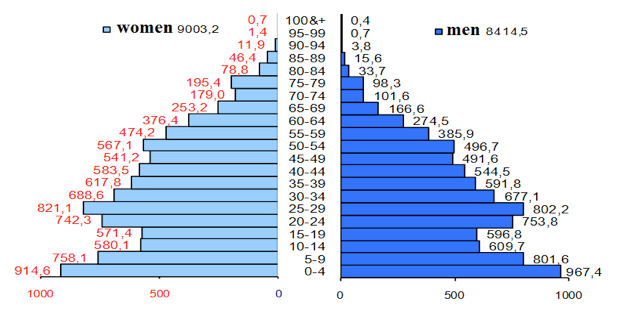
Figure 13. Age and sex structure of population in RK,
compiled on data of Statistics Agency of RK
As a whole the stable ratio of number of men and women testifies to existence of natural potential for a solution of the problem of growth of birth rate especially in the most productive for creation of a family and the birth of children age (20–35 years) the number of men and women in the Republic of Kazakhstan is almost identical (the relation of number of women to number of men makes 50,3: 49,7).
According to expected data of the RK statistic Agency till 2030 the trend of insignificant increase in number of the man's and female population remains. Since 2013 the female population will increase by 19% or by 1,68 million people and will reach in 2030 the value of 10,49 million people. The number of the man's population by 2030 will make 9,8 million people, having increased since 2013 by 19,6% or for 1,6 million people. The gender ratio remains at former level, with little change towards identical alignment (see Figure 15).
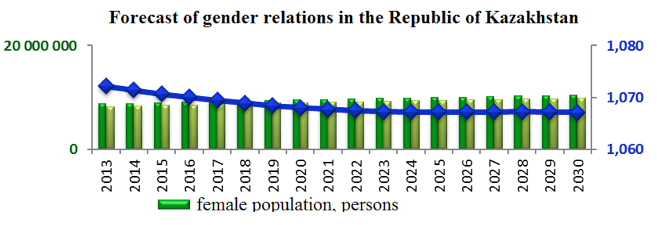
Figure 15. Average life expectancy,
compiled on data of Statistics Agency of RK
The increase in life expectancy of the population serves as the sixth demographic factor. The reason of such special attention of the majority of the states and in particular, the leading industrial countries of the world to problems of formation and the directions of further development of systems of provision of pensions is the problem of the accelerated aging of the population.
As a rule, these processes are connected, first of all, with achievements of medicine, prevention, the growth of quality of life and life expectancy. According to demographic forecasts, in the developed countries the tendency of the accelerated aging will progress within the next four decades.
In Kazakhstan this indicator is sure to grow up, since 1995, and at that time the average life expectancy of the population was on a mark of 65,3 years. Life expectancy grew by 6,95 years and rose to a mark of 70,45 years by data for 2013. Expected life expectancy of men was the lowest in 1994-1995 and was equal to 58 years. By the end of 2013 life expectancy of men was extended for 7,8 years and reached a point of 65,75 years. The minimum value of life expectancy of women in 1994 made 69,4 years. For the last 18 years this indicator increased by 8% or by 5,7 years, having reached 75,06 years (see Figure 16).
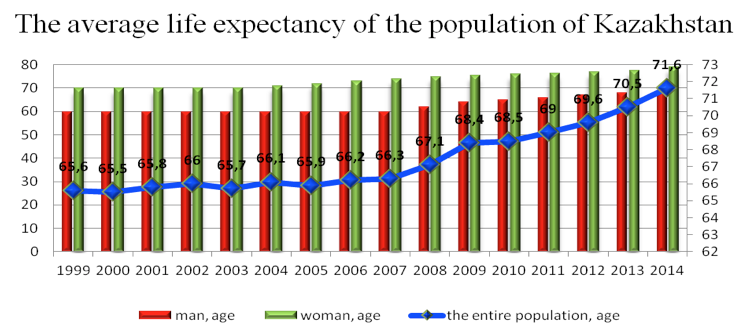
Figure 16. Dynamic coefficient of demographic burden in RK,
compiled on data of Statistics Agency of RK
The seventh demographic factor is the increase in loading at able-bodied population. The coefficient of demographic loading gives information on a ratio of number of the disabled population to quantity of able-bodied population. It is considered that limit value of this indicator is the coefficient equal 0,7. In the republic the coefficient of demographic loading since 1999 didn't exceed value 0,27, and in 2012 decreased to 0,2 (see Figure 17).
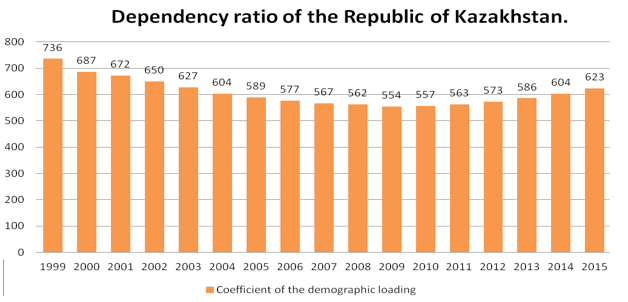
Figure 17. The dynamics of dependency ratio in Kazakhstan,
based on data of the ROK Agency for statistics
Having analyzed the forecast of this coefficient executed by the RK statistic Agency, we will note that the coefficient of demographic loading by 2030 increases, but is within admissible value (see Figures 18 and 19).
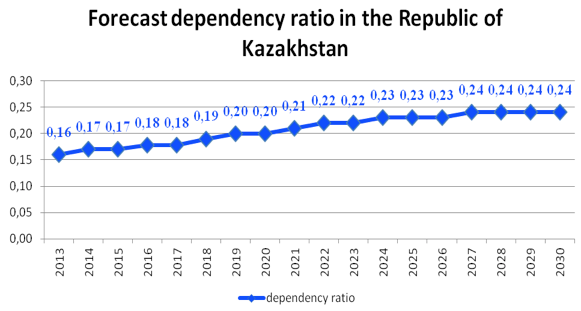
Figure 18. Forecast of dependency ratio in Kazakhstan,
based on data of the ROK Agency for statistics
Predicting value of coefficient of demographic loading in the RK according to three scenarios optimistic, realistic and pessimistic, it is possible to draw a conclusion that value of coefficient is in each of scenarios at admissible level.
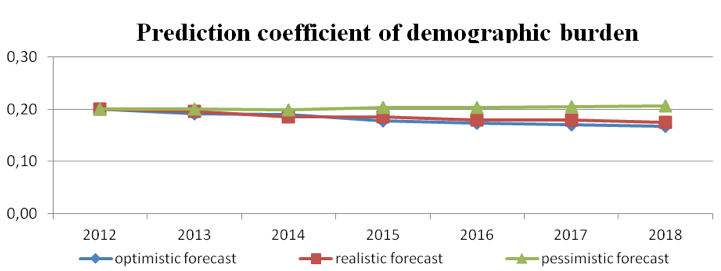
Figure 19. Forecast of dependency ratio in Kazakhstan (optimistic, realistic and pessimistic scenarios),
calculated according to data of Agency of statistics of Kazakhstan
Impetuous aging of the population nowadays more and more reincarnates in a universal problem of the present. For validity of an initiative of increase of a retirement age the rating of the countries on life expectancy of citizens on pension is made. The indicator which was cornerstone of ranging reflects probability to live up to pension for citizens and the general validity of an operating retirement age.
As a rule raise of the age pension does not have any forced character. It exists pliantly, more partial load mode on the chance of the retirement, but on the behalf of the existing adjustment pension. Citizens are given the opportunity of the choice and pliant adjustment pension is allowed on the existence of pensionable service or enough pension accumulations, and the right to have partial savings (USA, Canada, France, Italy, Germany, Dutch, Netherlands, Finland, Sweden).
Raising the retirement age in most cases is carried out in stages, with the differentiation of citizens/women transferred to the new conditions, age and other grounds (INR-godechot, the seniority of work in harmful and heavy working conditions, disability, etc.). Higher retirement age is usually from 2 to 6 months per year. For example, in South Korea, raising the retirement age for women to 65 will be implemented for 20 years in France to 62 years for 8 years, in Ukraine — up to 60 years for 10 years, etc.
As the Idea Lab edition reports 223 countries participate in a rating for 2014, made by the CIA of the USA. Monaco where people on the average live till 89,57 years heads the three of leaders, then Macau follows - 84,48 years and Japan - 84,46 years.
The place of honor in a rating is taken also by China where pensioners on the average live about 19 more years which is also can be explained by a low retirement age – 60 years for men and 50-55 years for women. And the retirement age in China didn't rise more than 60 years in spite of the fact that average life expectancy during this time grew from 43 to nearly 75 years. Mainly in the developed European countries, and also Australia and Canada the average indicator of life expectancy of citizens after a retirement makes from 15 to 18 years.
In Kazakhstan the growth of life expectancy is proclaimed as a reference point and planned to increase step by step by 2018 retirement age for women till 63 years that, first of all, is caused by deficiency of means in the budget and a level of development of pension system. Otherwise, in case of one-stage increase of a retirement age for women till 63 years, Kazakhstan considerably will worsen positions in the rating and at best it will be possible to keep the current low place in the rating.
In such countries as Denmark, Mexico, Ireland, Portugal, New Zealand, Germany, Japan, Finland, etc., the retirement age is already increased, and it is leveled for women and men, and in 5 countries which are Greece, Poland, Latvia, Hungary, Ukraine, this alignment is already taken into account (Luzina, Ignatova, 2016).
Citizens are given the opportunity of choice and pigtail on pension on existence of the necessary pensionable service or enough pension savings, and the rights of getting partial pension. (The USA, Canada, France, Dutch, Netherlands, Finland, Sweden, etc.).
In Kazakhstan the problem of prompt aging of the population, certainly, also takes place, however, it is presented in the agenda less sharply, than in the majority of the countries presented in the rating. The Ministry of Labour and Social Protection of the population proves increase of a retirement age by the need of:
• increase in an experience of participation in APS (accumulative pension system) and corresponding increase in volume of pension accumulation. In Kazakhstan the problem is seen much more sharply not in duration of depositing of pension contributions, but in system of nonparticipation of the most part of citizens in accumulative system.
In turn this problem is a consequence of the huge hidden unemployment and that self-busy citizens practically don't deduct contributions to pension funds. The inevitable result of such practice is lack of pension at the majority of citizens in future after cancellation of solidary system. Actually all country people will be practically without pension in the long term. In other words, increase of a retirement age won't promote growth of accumulation of citizens who don't make pension assignments;
• leveling of growth of coefficient of demographic loading in connection with aging of generation of "baby-boom" (given rise in post-war years). Growth of number of pensioners is compensated for the account of demographic lifting. "Baby–boom" took place worldwide, but the governments of many countries don't hurry with increase of a retirement age, expansion of opportunities of involvement of an additional manpower to a labor market due to extension of economically active age.
Positive functioning of pension system in the country depends on many factors, including conditions of separate branches of the economy whose change involves immediate reflection in pension system. The special place among all factors is taken by factors of demographic character.
The first such demographic factor, in our opinion, is population aging in the country. The share of the population older than 65 years in the total number of the population is the indicator measuring it.
At increase in number of elderly people relatively the total number of the population, the load, both on efficient part of the population, and on the state as a whole increases. The state will be compelled to carry out additional measures for completion of the pension assets necessary for providing pensioners with pension payments. Such additional measures have an adverse effect on the balance of payments of the country and lead to undesirable results.
On the back of demographic processes taken place the significant changes of pension system and population employment structure whereanent the economist always try to understand and research such changes.
Following conclusions can be made according to results of a conducted research:
Alimukhambetov, N. (2007). We will create fund, which is less subject to risk. Panorama Journal, 48, 4.
Amandykova, S.K., Rakhymberlina, A.K. (2013). Topical issues of a pension system reform in the Republic of Kazakhstan. Bulletin of Karaganda State University, 3(14), 16-19.
Batayev, A.V. (2015). Perspectives of the Russian pension system development on the basis of actuarial calculations. Actual problems of economics, 9(171), 304-312.
Demidova, N.V. (2010). Pension plan making of RK. Evolution of management, achievement and shortfalls. Al’-Pary, 3, 44-49.
Demographic year-book of Kazakhstan (2016). Statistical collection. Astana: Statistical Agency of the Republic of Kazakhstan.
Kasenova, A.K. (1991). Statistical research of a modern social-demographic structure of population of the Republic of Kazakhstan. Senior thesis on procuring of science degree of a candidate of economic sciences on specialty 08.00.11. Moscow.
Kenzheguzhin M. (1999). Kazakhstan economy: from past towards future. Economy and statistics. Astana: Statistic agency of the Republic of Kazakhstan.
Khitakhunov, A.A. (2012). Migration process and its impact on labour market. Bulletin of “Turan” University, 4(56), 142-146.
King, R. (2012). Geography and Migration Studies: Retrospect and Prospect Population, Space and Place. Re-Making Migration Theory: Transitions, Intersections and Cross-Fertilisations, 2(18),134–153.
Kudrin, A.L., Gurevich, E.T. (2012). Population aging and a thread of budget crisis. Economy issues, 4, 52-79.
Kurmanova G.G. (2014). Some problems of investing of retirement assets of the Republic of Kazakhstan. Bulletin of Aktobe University named after S.Baisheva, 5(21), 24-26.
Luzina, T.V., Ignatova, I.V. (2016). Economic-law aspects of population migration regulation. Economics of region, 4(12), 1079-1089.
Madiyarova, D.M., Zhumagalievа, L.T. (2014). Retirement system in the Republic of Kazakhstan. Astana: Finance Academy JSC.
Nurmuganbetov, E. (2009). Analysis of pension service market of Kazakhstan. Market against securities of Kazakstan, 21, 84-87.
Perneyeva, G.A. (2013). Forming and development of pension system in RK. Bulletin of Vestnik KarNHU, 10(32), 114-118.
Plewa, P. (2012). The Effects of Voluntary Return Programmes on Migration Flows in the Context of the 1973/74 and 2008/09 Economic Crises. Comparative Population Studies, 37, 147–176
Rysmakhanova, G.Zh. (1998). Statistical analysis of social-demographic structure of the Republic of Kazakhstan population and its dynamics. Senior thesis on procuring of science degree of a candidate of economic sciences on specialty 08.00.11. Moscow.
Serikbayeva, S.G. (2005). Statistical research and forecasting the Republic of Kazakhstan population structure. Senior thesis on procuring of science degree of a candidate of economic sciences on specialty 08.00.12. Moscow.
Shapiro, V. (1986). The main directions of social policy concerning the elderly population. The Population of the third age. Moscow: Thought.
Shokamanov, U. (2000). Human development tendency in Kazakhstan. Almaty.
Shudabay, K.K. (2014). Analysis of non-budgetary fund use of Kazakhstan. Bulletin of Aktobe University named after S.Baisheva, 4(21), 5-8.
Sinyavskaya, O.V. (2002). Assessment of economic consequences of possible change of a retirement age. The thesis and the abstract on VAK 08.00.05 for Candidate of Economic Sciences. Moscow.
Soloviyev, A.K. (2016). Demographic risk of the Russian pension reform. Economics of region, 1(12), 162-174.
Stephen, G. (2011). Migration, Crisis, and the Global Labour Market. Globalization, 8(3),311–324.
Zakharov, S.V., Ivanova, E. (2002). Demographic tendencies and economic activity of the population. The employment Review in Russia. Release 1 (1991 - 2000). Moscow: Bureau of the economic analysis.
1. Eurasian National University L.N. Gumilev – Kazakhstan. E-Mail: mdm-diana@mail.ru
2. Eurasian National University L.N. Gumilev – Kazakhstan
3. Eurasian National University L.N. Gumilev – Kazakhstan
4. Eurasian National University L.N. Gumilev – Kazakhstan
5. Eurasian National University L.N. Gumilev – Kazakhstan
6. Eurasian National University L.N. Gumilev – Kazakhstan
7. Eurasian National University L.N. Gumilev – Kazakhstan